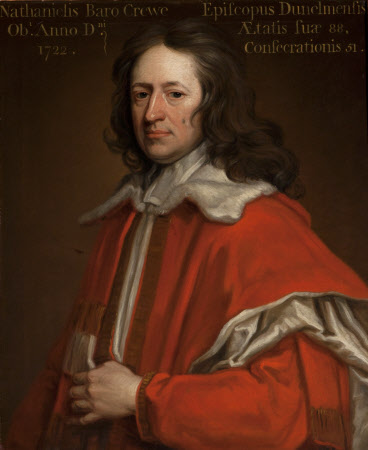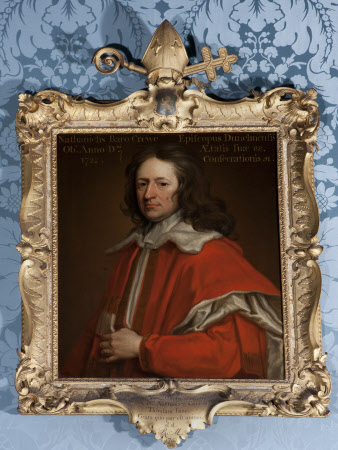Nathaniel Crew, 3rd Baron Crew of Stene (1633-1722), Bishop of Durham
studio of Sir Godfrey Kneller (Lübeck 1646 - London 1723)
Category
Art / Oil paintings
Date
1698 (after) - 1740
Materials
Oil on canvas
Measurements
737 x 610 mm (29 x 24 in)
Place of origin
England
Order this imageCollection
Kedleston Hall, Derbyshire
NT 108813
Summary
Oil painting on canvas, Nathaniel Crew, 3rd Baron Crew of Stene (1633-1722), Bishop of Durham, studio of Sir Godfrey Kneller (Lübeck 1646/9 - London 1723), inscribed: Nathanielis Baro Crewe Episcopus Dunelmensis / Obt. Anno Dni. 1722. Aetatis suae 88 / Consecrationis 51 A half-length portrait, turned to the left, gazing at the spectator, dressed in crimson gown. The original, three-quarter-length painting, dated 1698 is now in the Bodleian Library, Oxford. Lord Crewe is supposed to be the first peer to have held a bishopric. He was Bishop of Oxford from 1671 to 1674, and Bishop of Durham from then until his death, and stood in high favour under James II. Despite two marriages, he died childless, and the barony became extinct. His aunt, Patience, married Sir John Curzon, lst Bt, and both families seem to have adopted the name Nathaniel for their children about the same time
Provenance
Given by his old tutor, Robert Mather, to Sir Nathaniel Curzon; recorded in Lady Scarsdale’s Dressing Room by 1769; and thence by descent until bought with part of the contents of Kedleston with the aid of the National Heritage Memorial Fund in 1987 when the house and park were given to the National Trust by Francis Curzon, 3rd Viscount Scarsdale (1924-2000)
Credit line
Kedleston Hall, The Scarsdale Collection (acquired with the help of the National Heritage Memorial Fund and transferred to the National Trust in 1987)
Marks and inscriptions
Pracellenti Viro, faneto, erudito, comi, benefico, D no. Nathanieli Curzon Bart Tabulam hanc, Grato qou par est animo, d.d. R.M. 1751 (mark, painted, bottom of frame on moulded shield device, black text on gold)
Makers and roles
studio of Sir Godfrey Kneller (Lübeck 1646 - London 1723), artist
References
Warner 1802 Rev. R.Warner, Tour through the Northern Counties, 1802, Kiddlestone House [sic], vol.I, pp.124-5

